| Columns Retired Columns & Blogs |
Cary Audio Design Classic CD 303T Professional SACD player Measurements
Sidebar 3: Measurements
I measured the Cary Classic CD 303T SACD Professional Version player with Stereophile's loaner Audio Precision SYS2722 system. (See www.ap.com and "As We See It" in the January 2008 issue.) For some tests, I also used my Audio Precision System One Dual Domain and the Miller Jitter Analyzer. Complicating the task was the range of operational options offered by the Cary: tube or solid-state output stage; balanced or unbalanced output; CD or SACD playback; one of six oversampling rates, or none; external S/PDIF or USB data inputs. To have fully characterized this product's performance in every possible mode would have meant postponing this issue's publication until October! I therefore performed a full set of tests for the four primary combinations of balanced tube and solid-state, no oversampling and the most extreme oversampling (to 768kHz), with snapshots of the CD 303T's behavior fed with external S/PDIF and USB data and in unbalanced mode.
Measured with the "provisional" Sony test SACD, the Cary 303T gave a maximum output level of 6.1V, balanced solid-state, and 5.78V, balanced tube. Unless accounted for, the resulting 0.6dB difference would be enough to affect any comparisons of the Cary's tube and solid-state operation. The levels were slightly higher for solid-state CD playback without upsampling, at 6.235V and 5.83V, respectively, while the unbalanced output levels in both modes were exactly half these levels, as expected. Upsampling very slightly reduced the maximum levels, but not enough to invalidate any comparisons. The tube output stage clipped at full level into loads much below 10k ohms.
Both balanced and unbalanced outputs inverted absolute polarity in both solid-state and tube modes, even though the XLRs are wired with pin 2 hot. The balanced solid-state output impedance was an even 200 ohms across the audioband, the unbalanced figure exactly half that. The tube stage's unbalanced output impedance was a low 372 ohms at 1kHz, rising to 392 ohms at 20kHz and 530 ohms at 20Hz.
Error correction for CD playback was good, the Cary suffering no audible glitches in its output with the Pierre Verany Test CD until the gaps in the data spiral reached 1.25mm in length. The coaxial S/PDIF input successfully locked to datastreams with sample rates ranging from 32 to 192kHz, though the TosLink input wouldn't operate above 96kHz with a plastic-cored interlink. The CD 303T's digital outputs correctly followed the sample rate set by the Upsample Output button. When I used the Cary's driver program on a PC running Windows XP with Service Pack 3 and played files with Foobar 2000, the 303T's USB input accepted data ranging from 44.1 to 192kHz, though the player's front-panel display showed "96kHz" for 192kHz data, and the audio bandwidth appeared to be restricted to 48kHz rather than the expected 96kHz. This suggests that my computer was downsampling the USB data to 96kHz. As the Cary's USB input won't operate with Macs, I couldn't investigate its behavior more thoroughly with the Mac-only USB Prober program.
Fig.1 shows the frequency response of the Cary's solid-state output stage without upsampling for CD PCM data (green and gray traces), 96kHz S/PDIF PCM data (cyan and magenta), and SACD data (blue and red). The PCM formats rolled off steeply just before half the sample rate, as expected; the DSD data from SACD featured a slower ultrasonic rolloff, reaching –18dB at 80kHz. These responses were identical from the tubed output and with upsampling. I haven't shown the response with 192kHz-sampled S/PDIF data—it was identical to that with 96kHz data, suggesting that while the Cary's coaxial data input will lock to sample rates above 96kHz, the player downsamples those data to 96kHz. This will likely be academic, subjectively, but it puzzled me nonetheless. Channel separation (not shown) was superb in all modes, measuring at least 120dB below 4kHz or so.

Fig.1 Cary Classic CD 303T SACD, solid-state output, no upsampling, frequency response at –12dBFS into 100k ohms with data sampled at 44.1kHz data (left channel green, right gray) and 96kHz (left cyan, right magenta), and with DSD data at –3dBFS (left blue, right red; 1dB/vertical div.).
I tested the Cary's resolution in my usual fashion, feeding its S/PDIF input 16- and 24-bit data representing a dithered 1kHz tone at –90dBFS while sweeping the center frequency of a 1/3-octave bandpass filter from 20kHz to 20Hz; the resulting spectra, taken from the player's solid-state balanced output, are shown in fig.2. The traces peak at exactly –90dBFS, suggesting low linearity error, with no distortion- or power-supply–related spuriae visible. Increasing the word length drops the noise floor in the left channel by around 16dB, implying resolution close to 19 bits, which is excellent, and the player readily resolves a tone at –120dBFS, at least in the left channel (bottom solid trace). However, the right channel (dotted traces) is significantly noisier than the left below 1kHz, which can also be seen in the FFT-derived spectra with the same data (fig.3). This behavior was identical from the tubed output and was not affected by upsampling.
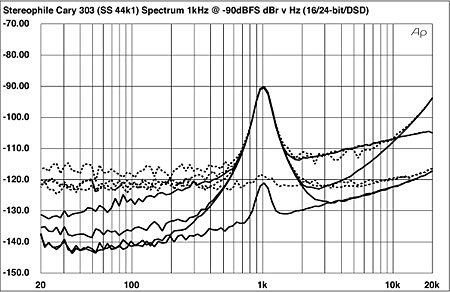
Fig.2 Cary Classic CD 303T SACD, solid-state output, no upsampling, 1/3-octave spectrum with noise and spuriae of dithered 1kHz tone at –90dBFS with 16-bit external data (top), DSD data (middle at 3kHz), and 24-bit external data (bottom). (Right channel dashed.)
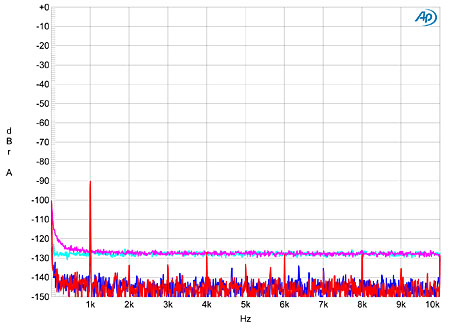
Fig.3 Cary Classic CD 303T SACD, solid-state output, no upsampling, FFT-derived spectrum with noise and spuriae of dithered 1kHz tone at –90dBFS with 16-bit external data (left channel cyan, right magenta) and 24-bit external data (left blue, right red).
To my considerable surprise, while SACD playback on this test was also excellent, I got a very different result when I repeated these tests playing back 16-bit data from CD. The top pair of traces at 1kHz in fig.4 are the same as in fig.2, the spectra of the two channels with external 16-bit data. The bottom traces show the behavior with CD playback of the same data—there is now a significant negative error in the level of the 1kHz tone, and a peak has appeared at 2kHz, the tone's second harmonic. The greater resolving power of the FFT spectral analysis (fig.5) reveals that there are also now traces of the fourth, sixth, and eighth harmonics present with CD playback. Again, this was not affected by switching to the tube output or by upsampling the CD data.

Fig.4 Cary Classic CD 303T SACD, solid-state output, no upsampling, 1/3-octave spectrum with noise and spuriae of dithered 1kHz tone at –90dBFS with 16-bit external data (top at 1kHz), and with internal CD data (top at 2kHz).

Fig.5 Cary Classic CD 303T SACD, solid-state output, no upsampling, FFT-derived spectrum with noise and spuriae of dithered 1kHz tone at –90dBFS with internal CD data (left blue, right red).
The same problem is revealed by comparing the Cary's linearity error with external 16-bit data (fig.6, top trace) with that for CD playback (bottom trace). The increasingly negative amplitude error below –80dBFS is due to energy being transferred from the fundamental tone to its even-order harmonics. Fed external data representing an undithered tone at –90.31dBFS, the Cary's output was perfect, with the three DC voltage levels clearly resolved (fig.7). But something is obviously amiss with CD data (fig.8), the two channels behaving incorrectly and differently. Again, this was not changed by upsampling the CD data. However, DSD playback was fine (fig.9), with the reconstructed waveform a good approximation of a sinewave.
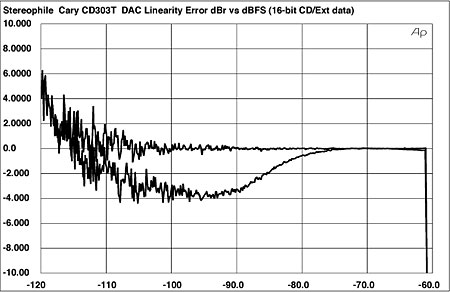
Fig.6 Cary Classic CD 303T SACD, left-channel linearity error with external 16-bit data (top) and internal CD data (bottom).
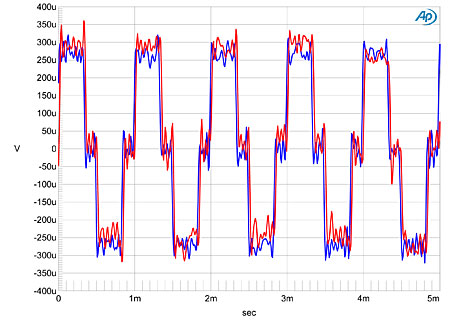
Fig.7 Cary Classic CD 303T SACD, tube output, no upsampling, waveform of undithered 1kHz sinewave at –90.31dBFS, external 16-bit data (left channel blue, right red).

Fig.8 Cary Classic CD 303T SACD, tube output, no upsampling, waveform of undithered 1kHz sinewave at –90.31dBFS, internal CD data (left channel blue, right red).
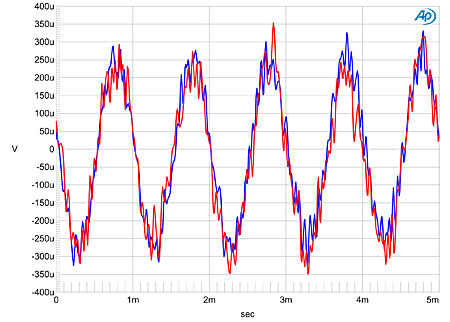
Fig.9 Cary Classic CD 303T SACD, waveform of dithered 1kHz sinewave at –90dBFS, DSD data (left channel blue, right red).
Turning to the Cary's behavior at high levels into a kind 100k ohm load, the distortion in its solid-state output was very low in absolute terms (fig.10), though the second harmonic was higher in the right channel than the left, at –94dB (0.002%) vs –110dB (0.0003%). All the harmonics increased in level from the tubed output (fig.11), though even the highest-level harmonic, the second, lay at a probably innocuous –73dB (0.02%). Reducing the load impedance to 10k ohms didn't introduce higher-order harmonics (not shown), but did increase second-harmonic distortion to –58dB (0.15%) and third-harmonic to –73dB, which suggests that the Cary's tubed output should not be used with loads below 10k ohms.

Fig.10 Cary Classic CD 303T SACD, solid-state output, no upsampling, spectrum of 1kHz sinewave at 0dBFS into 100k ohms, external 24-bit data (left channel blue, right red; linear frequency scale).
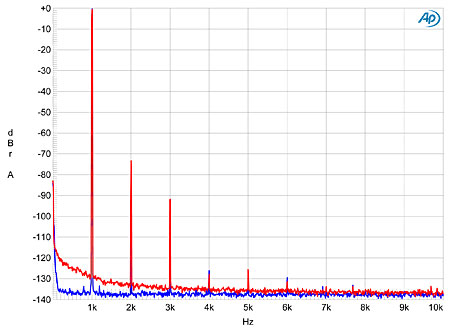
Fig.11 Cary Classic CD 303T SACD, tube output, no upsampling, spectrum of 1kHz sinewave at 0dBFS into 100k ohms, external 24-bit data (left channel blue, right red; linear frequency scale).
A similar increase in the level of the 1kHz difference component produced by a full-scale mix of 19 and 20kHz tones can be seen when the load on the unbalanced tube output was dropped from 100k ohms (fig.12) to 10k ohms (fig.13). The balanced tube output was a little better behaved than the unbalanced in this respect, but again, this implies that the Cary's tube output should not be used with loads below 10k ohms, a not-uncommon input impedance for solid-state preamplifiers. Intermodulation distortion from the solid-state output was very much lower, at <–86dB (0.006%), even into the punishing 600 ohm load.

Fig.12 Cary Classic CD 303T SACD, tube output, no upsampling, HF intermodulation spectrum, 19+20kHz at 0dBFS peak into 100k ohms, 24-bit data (left channel blue, right red; linear frequency scale).
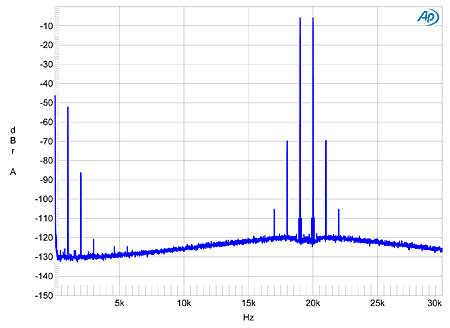
Fig.13 Cary Classic CD 303T SACD, tube output, no upsampling, HF intermodulation spectrum, 19+20kHz at 0dBFS peak into 10k ohms, 24-bit data (left channel blue, right red; linear frequency scale).
What was unusual about the Cary's intermodulation spectra was the top-octave rise in the noise floor, which suggests that some sort of noise modulation is occurring. This behavior was particularly noticeable when upsampling was used, and it can also be seen in fig.14, which shows a narrowband spectral analysis of the Cary's solid-state output while it played a CD carrying the J-Test signal (a high-level tone at exactly ¼ the sample rate and an LSB-level squarewave at exactly 1/192 the sample rate). While some low-frequency sidebands can be seen, these are almost at the residual level of the squarewave harmonics. The jitter level was below the resolution limit of the Miller Analyzer, so I haven't quoted a numeric figure. More noticeable, however, is the rise in the noise floor to either side of the spectral peak representing the 11.025kHz tone.

Fig.14 Cary Classic CD 303T SACD, solid-state output, 768kHz upsampling, high-resolution jitter spectrum of analog output signal, 11.025kHz at –6dBFS, sampled at 44.1kHz with LSB toggled at 229Hz, internal 16-bit CD data. Center frequency of trace, 11.025kHz; frequency range, ±3.5kHz (left channel blue, right red).
Performing the same analysis with external 16-bit data fed to the Cary from my PC via a 15' TosLink cable gave a measured jitter level of 565 picoseconds peak–peak, almost all of it due to sidebands at the signal-related frequencies of 11.025kHz ±229.5Hz (fig.15). Switching in 16Fs (768kHz) upsampling reduced the jitter to 506ps p–p, but the primary sidebands, of unknown origin, now lay at ±90Hz (fig.16). I haven't shown the jitter spectrum for the Cary fed 16-bit data via USB because I had to install the driver program on the same PC I use for the Audio Precision SYS2722. However, the Miller Analyzer, installed on an older PC running Windows ME, indicated the jitter to be a high 1880ps (1.88 nanoseconds), with the highest-level sidebands lying at ±252, ±298, ±339, and ±446Hz, and with the right channel's noise floor about 3dB higher than the left's.
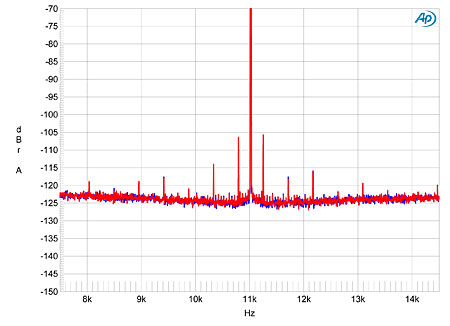
Fig.15 Cary Classic CD 303T SACD, solid-state output, no upsampling, high-resolution jitter spectrum of analog output signal, 11.025kHz at –6dBFS, sampled at 44.1kHz with LSB toggled at 229Hz, 16-bit CD data sourced form OC via 15' Toslink.. Center frequency of trace, 11.025kHz; frequency range, ±3.5kHz (left channel blue, right red).
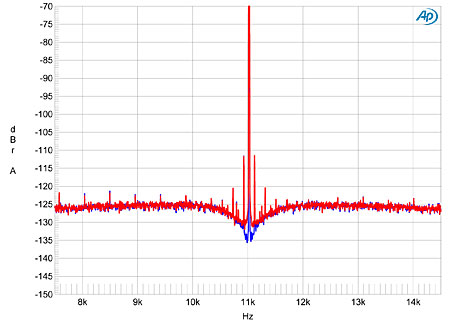
Fig.16 Cary Classic CD 303T SACD, solid-state output, 768kHz upsampling, high-resolution jitter spectrum of analog output signal, 11.025kHz at –6dBFS, sampled at 44.1kHz with LSB toggled at 229Hz, external 16-bit data from PC via TosLink. Center frequency of trace, 11.025kHz; frequency range, ±3.5kHz (left channel blue, right red).
I find it difficult to sum up the measured performance of the Cary Classic CD 303T SACD Professional Version. Used to play SACDs or to decode external data at sample rates up to 96kHz and word lengths up to 24 bits via its S/PDIF inputs, it offers truly excellent performance. But its CD playback is compromised by the low-level linearity error, and both the S/PDIF and USB inputs appear to downsample data with 176.4 and 192kHz sample rates. A puzzle.—John Atkinson
- Log in or register to post comments




































